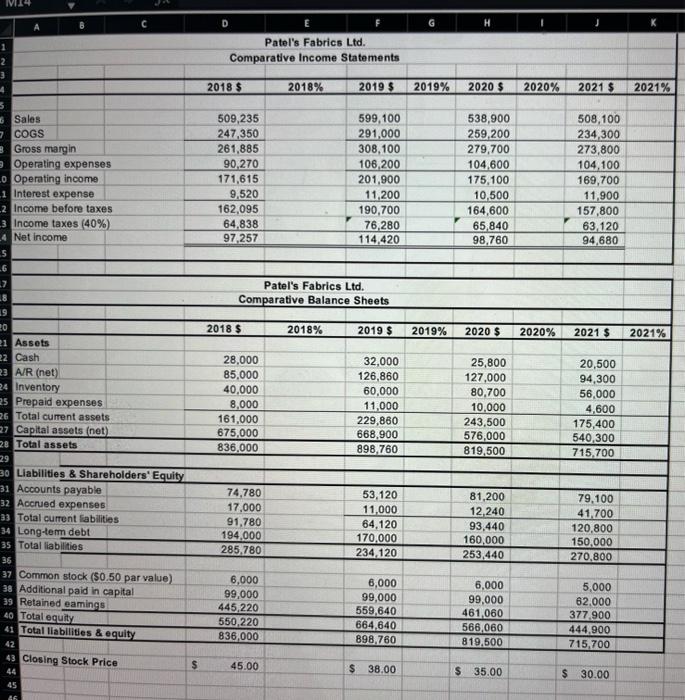Answered step by step
Verified Expert Solution
Question
1 Approved Answer
Perform a Horizontal analysis for the year 2018 to year 2021 Income Statement and Balance sheet. Perform a Vertical analysis (common size statements) for


Perform a Horizontal analysis for the year 2018 to year 2021 Income Statement and Balance sheet. Perform a Vertical analysis (common size statements) for the year 2018 to year 2021 Income Statement and Balance sheet. o Always consider the first year as the base year for the horizontal analysis. Provide your observations on the trends of the business, based on your horizontal and vertical analysis. Assess the business' liquidity by using liquidity ratios. o is the company's position improving or deteriorating? Explain your answer. Assess the business' profitability by using profitability ratios. o is the company's position improving or deteriorating? Explain your answer. Based on the above analysis (horizontal, vertical, and ratios), write a brief financial summary of the business, and explain any observed risks/weaknesses for the business. M14 1 2 3 4 5 6 Sales COGS Gross margin Operating expenses Lo Operating income 1 Interest expense 2 Income before taxes -6 17 3 Income taxes (40%) 4 Net income 5 18 B 19 20 21 Assets 22 Cash 23 A/R (net) 24 Inventory 25 Prepaid expenses 26 Total current assets 27 Capital assets (net) 28 Total assets 29 30 Liabilities & Shareholders' Equity 31 Accounts payable 32 Accrued expenses 33 Total current liabilities 34 Long-term debt 35 Total liabilities 36 37 Common stock ($0.50 par value) 38 Additional paid in capital 39 Retained eamings 40 Total equity 41 Total liabilities & equity 42 43 Closing Stock Price 44 45 46 $ D Patel's Fabrics Ltd. Comparative Income Statements 2018 $ 509,235 247,350 261,885 90,270 171,615 9,520 162,095 64,838 97,257 2018 $ 28,000 85,000 40,000 8,000 161,000 675,000 836,000 74,780 17,000 91,780 194,000 285,780 6,000 99,000 445,220 E 550,220 836,000 Patel's Fabrics Ltd. Comparative Balance Sheets 45.00 2018% 2019 $ 2018% 599,100 291,000 308,100 106,200 201,900 11,200 190,700 76,280 114,420 2019 $ 32,000 126,860 60,000 11,000 229,860 668,900 898,760 53,120 11,000 64,120 170,000 234,120 6,000 99,000 559,640 664,640 898,760 $ 38.00 2019% 2019% H 2020 $ 538,900 259,200 279,700 104,600 175,100 10,500 164,600 65,840 98,760 2020 $ 25,800 127,000 80,700 10,000 243,500 576,000 819,500 81,200 12,240 93,440 160,000 253,440 6,000 99,000 461,060 566,060 819,500 $ 35.00 2020% 2020% J 2021 $ 508,100 234,300 273,800 104,100 169,700 11,900 157,800 63,120 94,680 20,500 94,300 56,000 4,600 2021 $ 2021% 175,400 540,300 715,700 79,100 41,700 120,800 150,000 270,800 5,000 62,000 377,900 444,900 715,700 K $ 30.00 2021%
Step by Step Solution
★★★★★
3.42 Rating (158 Votes )
There are 3 Steps involved in it
Step: 1
To perform the horizontal analysis we will calculate the percentage change from 2018 to 2021 for the income statement and balance sheet items We will ...
Get Instant Access to Expert-Tailored Solutions
See step-by-step solutions with expert insights and AI powered tools for academic success
Step: 2

Step: 3

Ace Your Homework with AI
Get the answers you need in no time with our AI-driven, step-by-step assistance
Get Started


